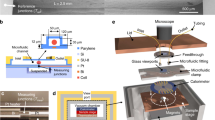Abstract
The metabolism of cells is studied by scientists using a number of cells high enough to have a signal in the regular differential scanning calorimetry (DSC). Currently the number of cells necessary for thermal analysis is on the order of hundreds of thousands. The cell metabolism researchers have been trying to reduce this number with an eye on the final prize of sample size of one. In this paper, we report a novel MEMS_DSC (Micro Electro Mechanical System-Differential Scanning Calorimetry), which reduces the number of cells needed for analysis by about two orders of magnitude. It uses the Seebeck effect generated by a polysilicon n-gold junction to convert the temperature measured from cells directly into a voltage signal. To characterize the device a laser was used to heat the sensor; a lock-in amplifier, coupled with an optical chopper, allowed us to measure a very low heat power (25.5 nW).





Similar content being viewed by others
References
Badran M, Moussa M (2005) BioMEMS implants for neural regeneration after a spinal cord injury, ICMENS, pp 89–90
Hanein Y, Böhringer KF, Wyeth RC, Willows AOD (2002) Towards MEMS probes for intracellular recording. In: Baltes H, Fedder GK, Korvink JG (eds) Sensors update sensor technology applications markets, vol 10, pp 47–75
Koester D, Cowen A, Mahadevan R, Hardy B (revision 10) PolyMUMPs design handbook, MEMSCAP
Li L, Tian Y-C, Tade MO, Feng Y, Qu SS (2003) Apoptosis of tumour cells by temperature anti-tumour drug: microscopic and macroscopic investigations. J Therm Biol 28:321–329
Liu Y, Wang C, Zheng C, Wang Z, Wu H, Qu SS (2001) Microcalorimetric study on the enhanced antitumor effects of 1-hexylcarbamoyl-5-Tuorouracil by combination with hyperthermia on K-562 cell line. Thermochim Acta 369:51–57
Monti M, Ikomi-Kumm J, Ljunggren L, Lund U, Thysell H (1993) Medical application of microcalorimetry in human toxicology. A study of blood compatibility of hemodialysis membranes. Pure Appl Chem 65:1979–1981
Scuor N, Gallina P, Panchawang HV, Mahajan RL, Sbaizero O, Sergo V (2006) Design of a novel MEMS platform for the biaxial stimulation of living cell. Biomed Microdevices 8:239–246
Serrell DB, Oreskovic TL, Slifka AJ, Mahajan RL, Finch DS (2007) A uniaxial bioMEMS device for quantitative force–displacement measurements. Biomed Microdevices 9:267–275
Tan A-M, Lu J-H (1999) Microcalorimetric study of antiviral effect of drug. J Biochem Biophys Methods 38:225–228
Wadso I (1995) Microcalorimetric techniques for characterization of living cellular system. Will there be any important practical options? Thermochim Acta, 269/270:337–350
Wang L, Wang B, Lin Q (2008) Demonstration of MEMS-based differential scanning calorimetry for determining thermodynamic properties of biomolecules. Sensor Actuators B 134:953–958
Wessel PR (1963) Reflectivity of silver–gold alloys in the spectral region 1.8–5 eV. Phys Rev 132:2062–2064
Author information
Authors and Affiliations
Corresponding author
Rights and permissions
About this article
Cite this article
Maggiolino, S., Scuor, N., Mahajan, R.L. et al. MEMS_DSC: a new device for microcalorimetric analysis in the biological field. Microsyst Technol 16, 967–971 (2010). https://doi.org/10.1007/s00542-010-1068-y
Received:
Accepted:
Published:
Issue Date:
DOI: https://doi.org/10.1007/s00542-010-1068-y




